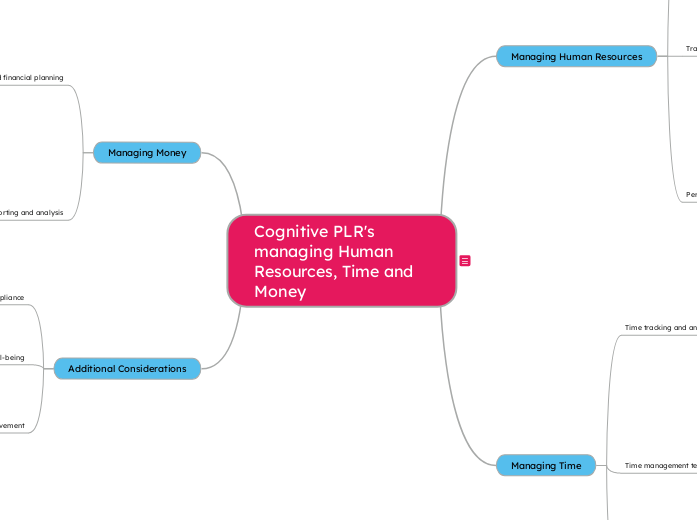Cognitive PLR's managing Human Resources, Time and Money
Managing Human Resources
Recruitment and hiring process
Job analysis and job descriptions
Identify the skills and qualifications needed for each position
Develop detailed job descriptions
Sourcing and attracting candidates
Advertise job openings
Utilize recruitment agencies or online platforms
Screening and selecting candidates
Review resumes and applications
Conduct interviews and assessments
Training and development
Assessing training needs
Identify skills gaps and areas for improvement
Conduct employee performance evaluations
Designing and implementing training programs
Develop training modules and materials
Determine the most effective training methods
workshops
online courses
Evaluating training effectiveness
Measure the impact of training on employee performance
Gather feedback from employees
Performance management
Setting performance goals and expectations
Establish clear objectives for employees
Communicate performance standards
Monitoring and providing feedback
Regularly review employee performance
Offer constructive feedback and support
Performance appraisal and rewards
Conduct formal performance evaluations
Recognize and reward high-performing employees
Managing Time
Time tracking and analysis
Implementing time tracking systems
Utilize time tracking software or apps
Determine the level of detail required for tracking
by project
by task
Analyzing time usage patterns
Identify time-wasting activities
Determine areas where time can be better allocated
Time management techniques
Prioritization and planning
Identify and prioritize tasks based on importance and urgency
Create a daily or weekly schedule
Delegation and outsourcing
Determine tasks that can be delegated to others
Outsource certain activities to external professionals or agencies
Time blocking and productivity tools
Schedule specific blocks of time for focused work
Utilize productivity tools or techniques (e.g
Managing interruptions and distractions
Minimizing interruptions
Establish clear boundaries and communication protocols
Use "do not disturb" features or office signage
Handling distractions
Develop strategies to stay focused (e.g
removing temptations
practicing mindfulness)
Managing Money
Budgeting and financial planning
Creating a budget
Assess current financial situation and goals
Allocate funds to different categories
salaries
training
operations
Monitoring expenses
Track and analyze financial transactions
Identify areas of overspending or cost-saving opportunities
Financial reporting and analysis
Generating financial reports
Prepare balance sheets
income statements
cash flow statements
Analyze financial performance and trends
Making financial decisions
Use financial data to inform strategic decision-making
Identify areas for improvement or investment
Additional Considerations
Legal compliance
Ensure compliance with labor laws and regulations
Stay updated on changes in employment legislation
Employee engagement and well-being
Implement strategies to promote employee satisfaction and motivation
Support employee well-being through policies and initiatives
Continuous improvement
Regularly assess and evaluate HR
time
and money management processes
Seek feedback from employees and stakeholders for improvement opportunities
